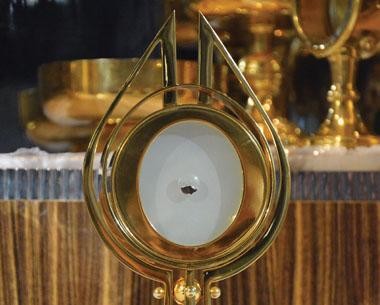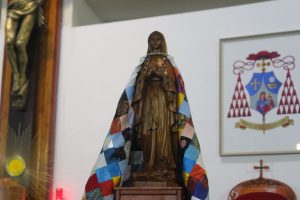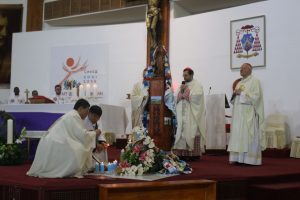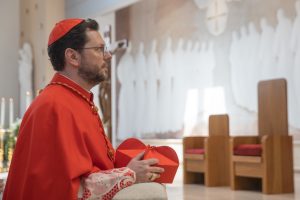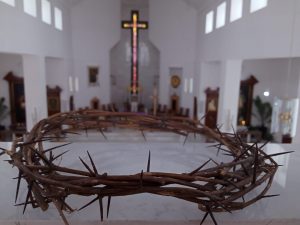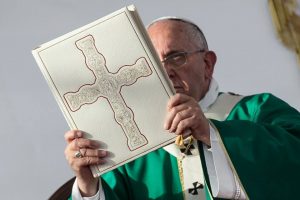A host that became a heart, or a heart that became a host?
In Poland, the consecrated Sacramental bread became part of human flesh. A miracle happened in the church of St. Hyacinth, in Legnica. In 2013, during the Christmas Mass, the Eucharistic Bread became human flesh after the transubstantiation.
Fr. Andrzej Ziombra, rector of the church of St. Hyacinth, recounts the details: “During the Holy Mass, the consecrated host fell to the floor. When this was discovered, the host was placed in a bowl of water. After 10 days, the host did not dissolve as expected … but a red spot appeared on it’’.
The local bishop commissioned a scientific examination. As a result of a study carried out by the the Department of Forensic Medicine at the Pomeranian Medical University of Szczecin (Poland), the material under study was identified as a myocardium – the human heart muscle fiber with changes that are often manifested under severe stress or agony.
The conclusion of the scientists was examined in Rome by the Congregation for the Doctrine of the Faith, and in 2016 the Church of Saint Hyacinth received official permission to display the Host for adoration.
O. Andrzej says that scientists still have a long way to go in further research to identify the human DNA that the Host contains, but now Legnica has become a centre for pilgrims who want to witness the miracle with their own eyes.
Miracle in Legnica – is it a host that has become a heart, or a heart that has become a host? The answer to this question can be found in the hearts of pilgrims who come to adore the relics. A monstrance with a wonderful Host is placed in front of the image of the Merciful Jesus, reminding that the conversion of the human heart to God is also a miracle that happens here, in the Legnica sanctuary, constantly.
Moon with black stripe
The event that took place in the city of Legnica in 2013 is one of the latest Eucharistic miracles, but it is far from the only one of its kind. So, in 1264, the most famous Eucharistic miracle took place, marking the beginning of the celebration of the Solemnity of the Most Holy Body and Blood of Christ.
The story takes us to Bolsena (Italy) and tells about a priest of German origin named Peter. The priest had doubts about the Eucharist, which arose due to the loud controversies of some theologians, who for the first time in the history of the Church questioned the real presence of Christ in the Transubstantiated Gifts. Once Fr. Peter, during his pilgrimage to Rome, stayed at the church of St. Christina in Bolsena to celebrate the Holy Mass. After he uttered a prayer for the transubstantiation, the host in the hands of Fr. Peter turned into bloody human flesh, except for the part that was clutched by the hands of a doubting priest. The miracle happened in front of the parishioners and strengthened the weak faith of the priest and many people who witnessed the miracle. Fr. Peter reported the incident to Pope Urban IV, who personally witnessed the miracle together with St. Thomas Aquinas. By order of the Pope, the Host, together with the corporal, on which blood was shed, were moved to Orvieto. Urban IV also commissioned Thomas Aquinas to compose the rite of the Mass and the Liturgy of the Hours for the feast of Corpus Domini. The ordinance of Aquinas was introduced at the same time with the publication of the papal bull Transiturus de hoc mundo, in which the Pope emphasized the importance of the Eucharist in the life of the Church and ordered the of celebration of the Solemnity of the Most Holy Body and Blood of Christ.
It is noteworthy that the events in Bolsena were preceded by visions of a Belgian nun. In 1209 St. Juliana of Liège, an Augustinian nun and mystic, saw the moon with a black stripe, which in subsequent visions was interpreted as a lack of the Eucharistic feast in the liturgical calendar of the Church. Together with her friend, Saint Eva, the visionary petitioned for the establishment of the feast of Corpus Christi for many years. She managed to convince the future Pope Urban IV, who at that time served as archdeacon in Liège, in the need for this feast. The future Pope Urban IV established the celebration of the Solemnity of the Most Holy Body and Blood of Christ first at the local level, and then in 1264 for the entire Catholic Church.
Divine mathematics, a careless priest and a love spell
It is known that the first Eucharistic miracle dates back to 750 and took place in the Italian city of Lanciano. The circumstances surrounding it are in many ways similar to the story from Bolsena. After the prayer of transubstantiation, the host visibly turned into body and blood, in response to the doubts of the priest who was celebrating the Mass. The flesh has remained incorruptible for 13 centuries, and the blood is divided into five unequal parts, each of which has the same weight as all of them, weighed together. This contradicts all the laws of natural science and mathematics and can be explained by the secret Christian faith, which professes that in every drop of transubstantiated wine God abides in all His fullness.
However, Eucharistic miracles occurred not only where faith was weakened and doubts were present, but also in order to warn people against negligence and malpractice.
So, in 1330 in Siena (Italy) there was a case when a priest was urgently summoned to visit a sick person. In his haste, he did not place the consecrated Hosting in a special vessel, but put it between the pages of the breviary. When the priest opened the book, he found prints of blood on its pages, and one of the pages has survived to this day.
Sometimes Eucharistic miracles happened to resist sacrilege and abuse of the Holy Gifts. In the Portuguese city of Santarem in 1266, a young woman turned to a sorceress to help her bewitch her unfaithful husband. The sorceress agreed, but said that for the love potion she must go to the church and bring the transformed Host from there.
The woman received the sacrament, she did not swallow it, but wrapped it in a cloth, on which traces of blood immediately appeared. The frightened woman ran home. Unfolding the cloth, she saw that the Host was bleeding profusely. The woman hid the bleeding cachet in the bedroom, and at night such a strong light began to emanate from the host that the room became as bright as day. When her husband asked what had happened, the woman had to confess everything she had done. The next day, the couple told the priest about the incident. The wonderful Host, accompanied by a procession, was returned to the church of St. Stephen, where she continued to bleed for another 3 days. Since then and to this day in Santarem, in memory of this event on the second Sunday of April, the shrine is carried in procession from the house of the couple, which became a chapel in 1684, to the church St. Stephen.
The boy who loved computers and the Eucharist
In total, over 100 miracles associated with the Eucharist have been recorded. The geography of the Eucharistic miracles is vast, and the stories cannot leave you indifferent. If you are interested in learning more about the Eucharistic miracles, we invite you to visit the website of Carlo Acutis: http://www.miracolieucaristici.org/. On the website you can see a map of the Eucharistic miracles and read in detail about each of them. You can also freely download the ready-made presentation material, print it and organize an exhibition dedicated to the Eucharistic miracles anywhere in the world.
Carlo Acutis was only 12 years old at the start of the project. The boy spent 3 years on creating the website, in 2006 he passed away, and in October 2020 Carlo Acutis will be proclaimed blessed.
Carlo Acutis was born on May 3, 1991 to an Italian family in London. The boy spent his childhood in Milan. As a teenager, Carlo displayed an extraordinary talent for information and computer technology, as well as a great love for the sacrament of the Eucharist.
In 2002, Carlo and his parents visited Rimini, where a priest they knew was introducing the Short Catechism on Eucharist. What he saw made a strong impression on the teenager, and he got the idea to create an exhibition about the Eucharistic miracles. At that time, he was also helping catechists, and the project seemed to him a new way of thinking about the Mystery of the Eucharist.
Immediately after returning from Rimini, Carlo gets down to business. He asks his parents to organize a trip to Italy and other European countries to collect the necessary photographic materials. Acquaintances are gradually involved in the process. People start talking about the exhibition, and suddenly it becomes in demand not only in the Italian dioceses, but all over the world.
In the summer of 2006, Carlo asks his mother: “Do you think I should become a priest?”, Antonia answered him simply: “You yourself will understand. God will tell you”. In early October, the boy suddenly fell ill and was taken to the hospital. At the hospital, Carlo is diagnosed with acute leukemia. Doctors are powerless to do anything, and the boy decides to devote his sufferings for the Pope, the Church and for not going to purgatory and going straight to Heaven. He does not talk more about suffering, and when asked by the nurses about his well-being, he answers: “Everything is fine. There are those who are much worse”. Soon Carlo receives the Last Rites and on October 12, his soul goes to God.
Antonia, Carlo’s mother recalls that the church was overcrowded on the day of the funeral. “People I have never seen before came. Homeless people, immigrants, children… Many people talked about Carlo, about what he did – I didn’t know anything about it. I felt orphaned, and they testified to me about my son’s life”.
The testimony of Carlo himself crossed the threshold of death and transformed more than one life. Thanks to friends and the Internet, the story and thoughts of the Italian teenager have become known far beyond his social circle. The Acutis family receives hundreds and hundreds of letters from people wanting to know more about him. The exhibition, created by a teenager, with the help of the Brotherhood of the Knights of Columbus, managed to visit many parts of the world, reaching Russia, China and Latin America. More than a hundred universities and a huge number of parishes accepted it. The Carlo Acutis Association continues the work of the unusual teenager, the website is updated with new information and translated into different languages.
“My son became a priest in Heaven, – Antonia is convinced, – He could not come to terms with the fact that concerts are filling stadiums, while the churches are empty. And he kept repeating: “They must understand’’.
They must understand what? Probably the fact that the Eucharist is the most amazing gift to humanity and the greatest miracle that takes place on our planet every day. Blessed Carlo Acutis, pray for us.
